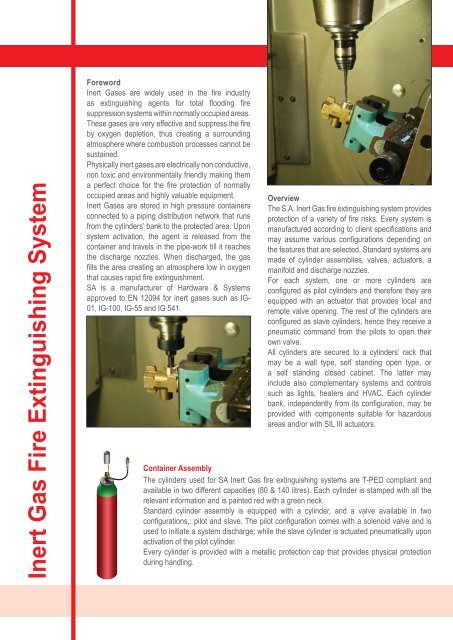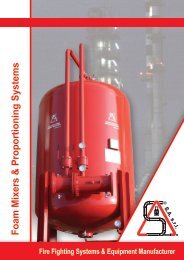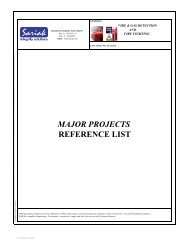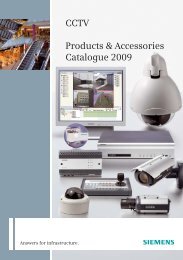Inert Gas Fire Extinguishing System - Sariak
Inert Gas Fire Extinguishing System - Sariak
Inert Gas Fire Extinguishing System - Sariak
Create successful ePaper yourself
Turn your PDF publications into a flip-book with our unique Google optimized e-Paper software.
<strong>Inert</strong> <strong>Gas</strong> <strong>Fire</strong> <strong>Extinguishing</strong> <strong>System</strong><br />
Foreword<br />
<strong>Inert</strong> <strong>Gas</strong>es are widely used in the fire industry<br />
as extinguishing agents for total flooding fire<br />
suppression systems within normally occupied areas.<br />
These gases are very effective and suppress the fire<br />
by oxygen depletion, thus creating a surrounding<br />
atmosphere where combustion processes cannot be<br />
sustained.<br />
Physically inert gases are electrically non conductive,<br />
non toxic and environmentally friendly making them<br />
a perfect choice for the fire protection of normally<br />
occupied areas and highly valuable equipment.<br />
<strong>Inert</strong> <strong>Gas</strong>es are stored in high pressure containers<br />
connected to a piping distribution network that runs<br />
from the cylinders’ bank to the protected area. Upon<br />
system activation, the agent is released from the<br />
container and travels in the pipe-work till it reaches<br />
the discharge nozzles. When discharged, the gas<br />
fills the area creating an atmosphere low in oxygen<br />
that causes rapid fire extinguishment.<br />
SA is a manufacturer of Hardware & <strong>System</strong>s<br />
approved to EN 12094 for inert gases such as IG-<br />
01, IG-100, IG-55 and IG 541.<br />
Overview<br />
The S.A. <strong>Inert</strong> <strong>Gas</strong> fire extinguishing system provides<br />
protection of a variety of fire risks. Every system is<br />
manufactured according to client specifications and<br />
may assume various configurations depending on<br />
the features that are selected. Standard systems are<br />
made of cylinder assemblies, valves, actuators, a<br />
manifold and discharge nozzles.<br />
For each system, one or more cylinders are<br />
configured as pilot cylinders and therefore they are<br />
equipped with an actuator that provides local and<br />
remote valve opening. The rest of the cylinders are<br />
configured as slave cylinders, hence they receive a<br />
pneumatic command from the pilots to open their<br />
own valve.<br />
All cylinders are secured to a cylinders’ rack that<br />
may be a wall type, self standing open type, or<br />
a self standing closed cabinet. The latter may<br />
include also complementary systems and controls<br />
such as lights, heaters and HVAC. Each cylinder<br />
bank, independently from its configuration, may be<br />
provided with components suitable for hazardous<br />
areas and/or with SIL III actuators.<br />
Container Assembly<br />
The cylinders used for SA <strong>Inert</strong> <strong>Gas</strong> fire extinguishing systems are T-PED compliant and<br />
available in two different capacities (80 & 140 litres). Each cylinder is stamped with all the<br />
relevant information and is painted red with a green neck.<br />
Standard cylinder assembly is equipped with a cylinder, and a valve available in two<br />
configurations,: pilot and slave. The pilot configuration comes with a solenoid valve and is<br />
used to initiate a system discharge; while the slave cylinder is actuated pneumatically upon<br />
activation of the pilot cylinder.<br />
Every cylinder is provided with a metallic protection cap that provides physical protection<br />
during handling.





